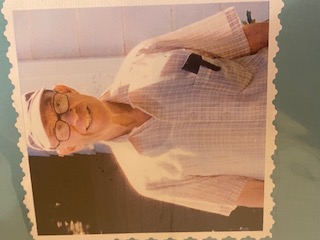Charlie was feisty. He was angry. He wanted to die. He crossed his arms and whooshed them apart before pointing downward. Finished. Kaput. I understood.
Charlie could no longer speak. His tongue and lips were not under his control. It happened slowly. A slight slurring of speech, a droopy lip. We visited doctors and dentists to find a reason for these occurrences. “It’s neurological” was the reply without any explanation of what could be done.
Despite his inability to speak, Charlie always made his wishes known. As his daughter, I understood his silent language. I loved him fiercely.
My family lived in Rego Park, Queens since 1964. Dad and I often walked to the World’s Fair grounds in Corona. Selma, my mother, had passed two years earlier. I was now living with my husband and children in Westchester. I visited Charlie weekly bringing Kosher food from Super Sol or Ben’s Deli. Other than his strange neurological abnormalities, Charlie, an avid walker, was fit for a man of 86 years. But now his gait was slowing. He could not chew and had to eat mashed up or soft foods.
When neither my sister nor I could reach him, I knew something was wrong. In a panic, I asked a close friend to drive me to his apartment. I found him lying on the floor in the hallway. Despite his protests, I called for an ambulance.
To Charlie’s dismay, we brought him to United Hebrew Geriatric of New Rochelle, a home for the aged and those in need of rehabilitation. “Hooome” was the only word he could elicit. I didn’t tell him explicitly, but I’m sure he knew we gave up the lease on his Queens apartment. I told him “… if I have to continue the difficult drive to see you, I could die before you”.
Charlie once said to me, “If I can no longer walk, I don’t want to live.” We were habitual walkers on city streets. His CAT scan showed water on the brain. He could shuffle but needed a guiding hand to walk. His doctor, a kindly Italian man of middle age, told Charlie that surgery could relieve the water pressure on the brain enabling him to walk again. We prayed that the surgery would restore his speech too. It didn’t. More neurological tests. The verdict – ALS amyotrophic lateral sclerosis, commonly known as
Lou Gehrig’s Disease. A slow, degenerative death sentence. Charlie refused intravenous feeding. He would rather starve.
Despite his DNR, Charlie lived for another year. I visited Hebrew Geriatric every day around my work and family schedule. There was a woman on the rehab ward who had a passing resemblance to my mom. Charlie waved to her and smiled. On his 87th birthday in September of 2012, I brought him a Carvel ice cream cake with his name emblazoned on it. His eyes lit up. He could only sip the ice cream after it had melted. Nevertheless, he proudly had me cut slices for his nurses.
Shira, his granddaughter, came to visit while on winter break from university. I watched as she bent over Charlie’s bed. Charlie caressed her face and long blonde hair which fell like a gauze curtain over him. The tenderness was palpable.
By November I felt ragged. The strain of watching Charlie’s daily decline was torturing me. I had to get away. I talked with his doctor who told me that if I didn’t care for myself, I couldn’t care for Charlie. My husband and I flew to Puerto Rico for a three day get away. I was rejuvenated.
On the first day of a wintry December, Charlie was restless. He looked to me like a concentration camp survivor. I convinced him to drink his yogurt. He got back into bed and started thrashing from side to side. I called in a nurse. She gave him an oxygen tube. As soon as she left, he yanked it off. I tried to put it back on. Charlie stayed my hand. I called his doctor.
He came quickly. He placed his face over Charlie’s and asked, “Charlie, are you afraid?” Charlie shook his head “no”. Charlie made his wishes known.
I held his hand as his breathing slowed. He became calm. We looked into each other’s eyes. He knew that I was ready to let him go; I would say Kaddish for him. I would be OK


1 Comment
So beautifully written, with such restraint and love.